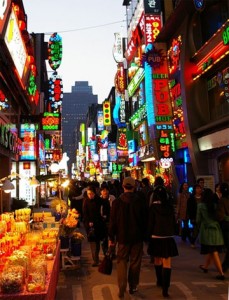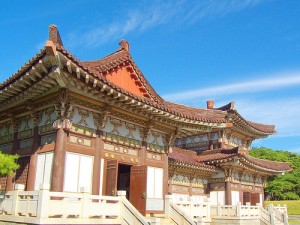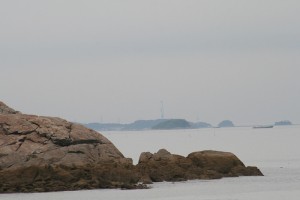March 9, 2011, 2:19 pm
 Capital, largest city and one of the most popular tourist destinations in South Korea = Seoul.
Capital, largest city and one of the most popular tourist destinations in South Korea = Seoul.
Asia fascinates me….the culture, food, the people, the tourist attractions…every country in Asia is unique and that is why you have to travel to a couple of destinations on this continent in order to get a feel for it. Having visited Japan, China and India, my next destination was to be Seoul in South Korea.
I would recommend booking flights to Incheon International Airport, which is the largest hub in South Korea and the main gateway to Seoul. I travelled with Delta Air Lines, but there are many other companies which operate flights to Seoul, such as Korean Air and Asiana Airlines.
So what is there to see? As I mentioned before, I decided to visit Seoul because I had never been to South Korea and where better to start than in the capital city. When I arrived in Seoul, I was taken aback by the number of palaces in the city. There are five and many of them are definitely worth visiting. Gyeongbok-gung is perhaps the most famous and apart from being a personal favourite, this palace has historical importance being the first one used by the Joseon Dynasty. Other important palaces to look out for are Changdeok-gung and Deoksu-gung. Like me, you will probably love wandering around this city because the architecture is so different and you will get to see shrines and temples you just don’t find in the western world.
After exploring the city, you should do what I did and head for the mountains…especially if you like hiking. The mountains in Seoul are accessible and especially designed for tourists as they have trails marked out. Bukhansan is perhaps one of the best mountains to visit and here you can take a tour of Bukhansan National Park. Not only can you enjoy hiking but you can get great pictures of South Korea’s landscape, birds and there are also lovely views of Seoul from the mountain.
I loved sightseeing by day, going on day trips and then by night trying South Korean food in a traditional restaurant. Don’t forget to buy some souvenirs before returning home. I would recommend going to Namdaemun, which is a market located in the centre of Seoul….here you will get lots of presents.
December 7, 2010, 8:22 pm
 If you’re traveling to Korea, you’ll need to know how to say some basic things as it’s not guaranteed that everyone you meet will be able to speak English. Korean is itself not too difficult a language to learn. The biggest barrier for most people seems to be the script, but that’s not an issue once you sit down to learn it. It’s all very logical and is based on easy to remember syllable sounds that are a combination of a consonant and a vowel. You can learn the script literally in a few days, then it’s just a matter of practice to read it and write it.
If you’re traveling to Korea, you’ll need to know how to say some basic things as it’s not guaranteed that everyone you meet will be able to speak English. Korean is itself not too difficult a language to learn. The biggest barrier for most people seems to be the script, but that’s not an issue once you sit down to learn it. It’s all very logical and is based on easy to remember syllable sounds that are a combination of a consonant and a vowel. You can learn the script literally in a few days, then it’s just a matter of practice to read it and write it.
Another difficult part of Korean is that it uses several thousand Chinese characters, commonly known as kanji. These are of course more difficult to learn, but they’re not impossible. They’re much harder to write though. They are often used in Korean to represent ideas or concepts, such as ‘love’, ‘hate’, ‘happiness’ and so on.
Greetings
Some common greetings in Korean:
good morning/afternoon annyong haseyo
good evening annyong hashimnikka
goodbye annyonghi kasayo
good night annyonghi jumushipsiyo
Introductions
How are you? Ch’oum poepgetsumnida.
My name is___ Chonun ______ imnida.
How are you? (informal) Ottoshimnikka?
Hello? (phone) Yoboseyo?
Common Phrases
Do you speak English? Yeongeorul malsum halsu isseoyo?
Yes Ne
No Aniyo
Thank you Kamsahaimnida
Sorry Mianhamnida
Numbers
1 hana 11 yol-hana
2 tul 12 yol-tul
3 set 13 yol-set
4 net 14 yol-net
5 tasot 15 yol-tasot
6 yosot 16 yol-yosot
7 ilgop 17 yol-ilgop
8 yodolp 18 yol-yodolp
9 ahop 19 yol-ahop
10 yol 20 sumul
30 sorun 40 mahun
50 shween 60 yesun
70 irun 80 yodun
90 ahun 100 baek
200 ee-baek 1000 ch’eon
10,000 man 100,000 ship-man
1,000,000 baek-man
This is just a few of the most important words and vocabulary to get you started in Korean. There are many resources available online to learn the language properly for your trip to Korea.
October 8, 2010, 10:48 am
 One thing that characterizes many visits to Korea is the vast crowds of people that you’re likely to come across no matter where you are. Luckily, this kind of experience tends to remain a part of a trip to one of the major cities. But if you’re the kind of person who would rather get away from the rat race and avoid large crowds, then Suncheonman Bay may be the place for you to go!
One thing that characterizes many visits to Korea is the vast crowds of people that you’re likely to come across no matter where you are. Luckily, this kind of experience tends to remain a part of a trip to one of the major cities. But if you’re the kind of person who would rather get away from the rat race and avoid large crowds, then Suncheonman Bay may be the place for you to go!
Suncheonman Bay is an incredible wildlife habitat made up of spacious tidal flats and reed fields which are in themselves a stunning landscape to take photographs of. In addition to the view though, the place is literally teeming with thousands of organisms, many rare and unique to the region. Suncheon itself has many tourist attractions – Seonamsa Temple which is celebrating its millenium, Naganeupseong Folk Village which dates back to the Joseon dynasty even though it is still inhabited and last but not least Suncheon Drama Film Set, which is the shooting location for many Korean popular TV shows and movies.
The Suncheon region is a mixture of both natural and ecological beauty and irreplaceable history in Korea.
Suncheonman Bay Eco-Observatory
The eco-observatory in Suncheon is one of the most popular destinations in the area. It is both a scientific station and a tourist hot spot. The center carries out research and also provides teaching in the ecology of the area. There is a collection of galleries, a theater, an ecology classroom and even a center to hold seminars. Outside, there is also a wetland observatory.
It’s possible to watch a host of wildlife such as migrating birds on CCTV cameras.
It’s very easy to get to Suncheonman Bay Eco-Observatory – it’s close to Yeosu airport which has direct links to Gimpo airport in Seoul.
August 24, 2009, 11:48 pm
 I traveled to Seoul in June (I wanted to avoid the rainy season and enjoy the weather before it became too humid) to see the city for the first time. Seoul is home to four UNESCO World Heritage Sites and I made it a priority to visit as many of them as I could while I was there.
I traveled to Seoul in June (I wanted to avoid the rainy season and enjoy the weather before it became too humid) to see the city for the first time. Seoul is home to four UNESCO World Heritage Sites and I made it a priority to visit as many of them as I could while I was there.
My first stop was to Hwaseong Fortress in Suwon, a satellite city located just 20 miles outside of Seoul. Built around 1800, much of the fortress was damaged during the Korean War. It was repaired in the 1970s and walking up to it today it still seems impenetrable. What makes it so unique and visually appealing is that it was built as a combination of designs from Europe, China, Japan and Korea. Its hybrid nature, while obvious in photographs, was truly beautiful up close. I toured the walls, the four gates and the artillery towers.
I was lucky that I was there on a Sunday because they have a demonstration by the “royal guards,” a reconstruction of what the guards would have looked like when the castle was built in the late 18th century. It was colorful and fairly enjoyable but I wouldn’t build my plans around it in the future. My trip to Hwaseong Fortress and Suwon city took an entire day but it was worth it. On my second day in Seoul I visited Changdeokgung Palace. It was named a UNESCO World Heritage Site in 1997 because of the way in which the architecture harmonizes with nature.
While that sounds sort of flowery and pompous, UNESCO got it just right. Buildings on the palace grounds are beautifully integrated with the property’s extensive gardens. It was all built in the 15th century and while some of the buildings on the site have been rebuilt, the bridge is the oldest bridge in Seoul.
I will say that I was initially put off by the fact that you have to be a part of a tour group to see it but it was well worth the cost and the English-speaking guide was really useful. Hwaseong Fortress was impressive and beautiful in its own stark way but the palace gardens and pavilions at Changdeokgung were gorgeous. I wouldn’t have traded my tour of the palace for anything.
Because my tour of Changdeokgung was fairly brief (about 90 minutes), I managed to see the Jongmyo shrine on the same day. The shrine was visually pleasing but it certainly wasn’t stunning. Built in the 14th century, dozens of Korean kings and queens are buried at Jongmyo. It was an important site for royal ancestor worship where five rituals took place each year to honor the royal dead.
These rituals are reenacted once a year in May (I missed it by a month) and would probably make the site much more interesting to visit. I decided not to visit the fourth World Heritage Site in Seoul (the Joseon Royal Tombs) because I wanted to spend a few days enjoying modern Korean culture but the three sites I did visit were well worth the time. I’d recommend them to everyone and if I go back I’ll be sure to visit the Joseon tombs.
 Capital, largest city and one of the most popular tourist destinations in South Korea = Seoul.
Capital, largest city and one of the most popular tourist destinations in South Korea = Seoul.

 I traveled to Seoul in June (I wanted to avoid the rainy season and enjoy the weather before it became too humid) to see the city for the first time. Seoul is home to four UNESCO World Heritage Sites and I made it a priority to visit as many of them as I could while I was there.
I traveled to Seoul in June (I wanted to avoid the rainy season and enjoy the weather before it became too humid) to see the city for the first time. Seoul is home to four UNESCO World Heritage Sites and I made it a priority to visit as many of them as I could while I was there.